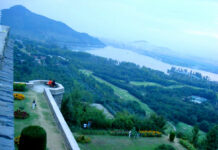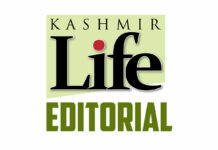Kashmir Life has completed nine years of uninterrupted publication and the credit goes to you, dear readers. You gave us the identity of being a credible source of news, knowledge and information, about Jammu and Kashmir because you read us, react to what we report, and ensure we do not misreport or under-report and event or a development in any sphere of life.
During all these years, the newsroom has worked overtime despite the limitations of resources, to ensure the correct reportage – both on our web and in print, disseminates in time. Sometimes, the news room did not sleep for nights to chase the developing stories. We believe this relationship will get stronger in coming days while the media would continue managing the new challenges in technology, news-gathering and dissemination.
As has been the tradition at Kashmir Life, we find occasions to work on thematic issues so that we deliver on a subject in one basket. Usually, we began our new year with a special issue and that is what we are starting the tenth year of our publication with – a special collection of reportage on the use and abuse of diversity in fragmenting an otherwise homogeneous society.
Diversity is globally being accepted as bliss. The socio-cultural and ethno-economic diversity that Jammu and Kashmir as a state offers is so vast that it can generate terabytes of data. Initially, the newsroom was so keen to tackle the entire diversity but time constraints and human resource issues in certain areas forced us to re-look at the so called homogeneity of Kashmir rather than the heterogeneity of the state.
Given the textbook ‘unity in diversity’, the special issue – after a marathon debate, decided to be dedicated to the ‘divisions in homogeneity’. Kashmir, by and large, is been seen more of an ethnic demography with less tensions and differences on issues of politics, development, social mores and, most importantly, the sacred and the profane. But, as this issue tried to explain, it has a huge twist. The idea of this issue is to see why the polity is so divided on almost every front, from faith to politics, caste to economics and between haves and have-nots. These fault-lines have always been there but the conflict seemingly has created gulfs and wedges that a small population of around seven million people may ill-afford on long term basis.
In the recent past, a lot of literature was created on this theme, with unwritten objective to limit the crisis that Kashmir is neck-deep in for last nearly three decades. This issue is addressing almost the same issue from an insider’s point of view.
There are questions being raised at ground zero: If all the Hurriyat’s have the same objective, why are multiple groupings on ground? How much is NC different from PDP and what are the costs if the mandate is fractured further? Why should the trade and industry be so much in so many groups that they lose their argument in their own diversity? In the crisis of conflict, what are the costs that have-nots are paying in the urban jungles of Srinagar? And, most importantly, why is faith being interrupted at the level of sects and sub-sects, and devouring the soul of Islam?
Kashmir Life newsroom has remained a frequent self-introspecting media outlet that has been identifying the crisis that Kashmir’s socio-economic life has been throwing up, as trends or exceptions. This is continuation of that series.
But this issue concludes with the comment by our regular columnist Khursheed Wani who emphasises on the fact that regardless of the prevalent faultiness, these cease to exist when Kashmir faces issues of identity and existence.
We hope to receive lot of reactions, suggestions and ideas. That is what keeps the show of life going on in Kashmir Life.
– Masood Hussain
Managing Editor










Best wishes on completing 9 years. Keep it up….